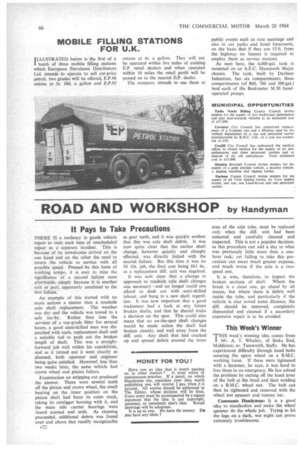ROAD AND WORKSHOP by Handyman
Page 62

If you've noticed an error in this article please click here to report it so we can fix it.
It Pays to Take Precautions
THERE IS a tendency in goods vehicle repair to treat each item of unscheduled repair as a separate incident. This is because of its unwelcome arrival on the .one hand and on the other the need to return the vehicle to service with all possible speed. Pressed by this form of working tempo, it is easy to miss the significance of a second failure soon afterwards, simply because it is another unit or part, apparently unrelated to the first failure.
An example of this started with no more serious a matter than a roadside axle shaft replacement. The weather was dry and the vehicle was towed to a safe lay-by. Rather than lose the services of a top-grade fitter for several hours, a good semi-skilled man was dispatched with tools, replacement shaft and a suitable rod to push out the broken length of shaft. This was a straightforward job well within his capabilities, and as it turned out it went exactly as planned, both operator and engineer being quite satisfied. Howevef, less than two weeks later, the same vehicle had crown wheel and pinion failure.
Examination on stripping out produced the answer. There were several teeth off the pinion and crown wheel, the small bearing on the inner position on the pinion shaft had burst its outer track. taking its outrigger housing with it, and the main side carrier bearings were found scarred and unfit. As cleaning proceeded, additional debris was found over and above that readily recognizable as gear teeth, and it was quickly evident that this was axle shaft debris. It was now quite clear that the earlier shaft change, however quickly and cheaply effected, was directly linked with the second failure. But this time it was no £8 10s. job, the final cost being £61 6s.. as a replacement diff, unit was required.
It was now clear that a change in approach to roadside axle shaft changes was necessary—and no longer could one afford to dash out with semi-skilled labour, and bang in a new shaft regardless. It was now important that a good tradesman had a look at any future broken shafts, and that he should make a decision on the spot. This could also mean that no on-the-spot shaft changes would be made unless the shaft had broken cleanly, and well away from the diff. unit. Any shaft that had cracked up and spread debris around the inner
area of the axle tube, must be replaced only when the diff, unit had been removed and carefully cleaned and inspected. This is not a popular decision, as this procedure can add a day to what was previously little more than a onehour task; yet failing to, take this precaution can mean much greater expense, and much worse if the axle is a twospeed one.
It is wise, therefore, to inspect the broken sections of shaft. Where the break is a clean one, go ahead by all means, but where there is debris well inside the tube, and particularly if the vehicle is also towed some distance, the diff, should be removed, completely dismantled and cleaned if a secondary expensive repair is to be avoided.
This Week's Winner
THIS week's winning idea comes from Mr. A. T. Whalley, of Stoke End, Middleton, nr. Tamworth, Staffs. He has experienced difficulty through hand bolts securing the spare wheel on a B.M.C. working loose. If these were tightened with a hammer, he says, it was hard to free them in an emergency. He has solved the problem by cutting off the hand lever of the bolt at the bend and then welding on a B.M.C. wheel nut. The bolt can then be tightened and removed with the wheel nut spanner and tommy bar.
Comments Handyman: It is a good idea to standardize and make the wheel spanner do the whole job. Trying to hit the lugs on a dark, wet night can prove extremely troublesome.
















































































































































